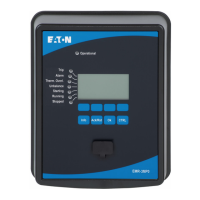The Start to Run transition is based on the setting [Protection Para / MStart / Start
Control] »TRN Criteria«, which has four transition behaviors for the user to select:
• “TRN TIME” — Transition to RUN after the set time »TRNT«. The current is ignored.
• “TRN I” — Transition when the starting current has dropped below the
setting »TRNC«.
If the »TRNT« timer elapses before the current drops below »TRNC«, the motor trips.
•
“TRN T or I” — Transition on time or current, whichever comes rst.
•
“TRN T and I” — Transition on time and current.
Both must occur, and the current must drop below »TRNC« before the
timer »TRNT« elapses.
If the timer expires before the current falls below the transition level, the motor trips.
If there is no transition trip, the protective device relay declares a successful transition to
RUN cycle and the corresponding transition ag(s) (current or time, or both, depending on
the settings and motor current) is set. The transition ag(s) is the part of the global
output list, which can be assigned to any module input or relay output. If it is assigned to
a relay output, it can control a reduced-voltage starter, switching to full running voltage.
Even if the transition control output contact is not used, the transition function can
provide clear indications of the actual state of the motor (START versus RUN) on the front
panel display and via data communications. A good way to do this is to use the settings
of »TRN Criteria« = “TRN T or I”, and »TRNC« = 130% ⋅ FLA. Modify the latter, if needed,
to set it to a transition value between the starting current and the post-start maximum
load current. Set the transition timer well beyond the normal start time to avoid a
transition trip.
144 www.eaton.com EMR-3MP0
4 Protective Elements
4.2 Motor Starting and Control Module

